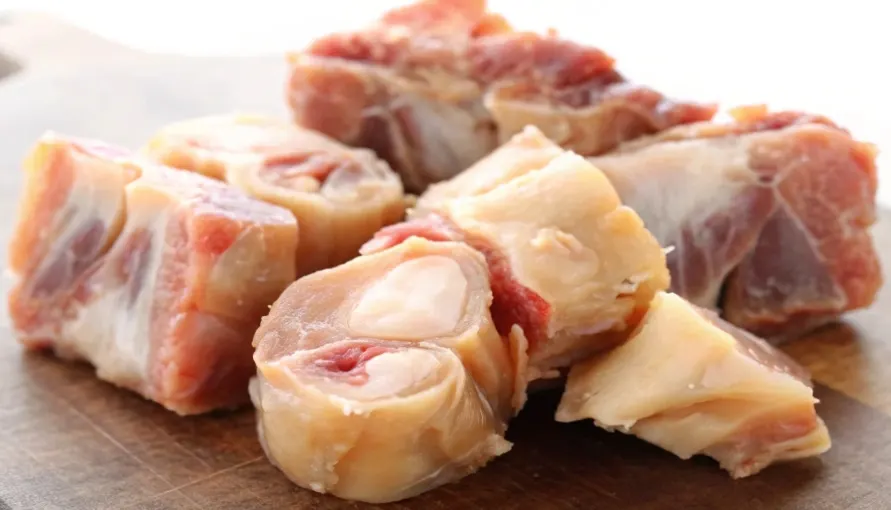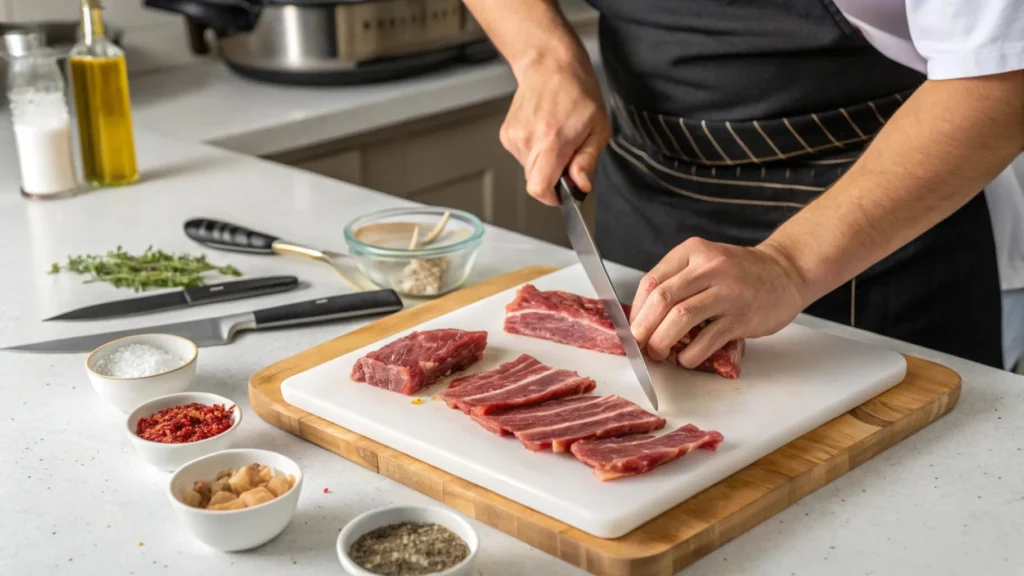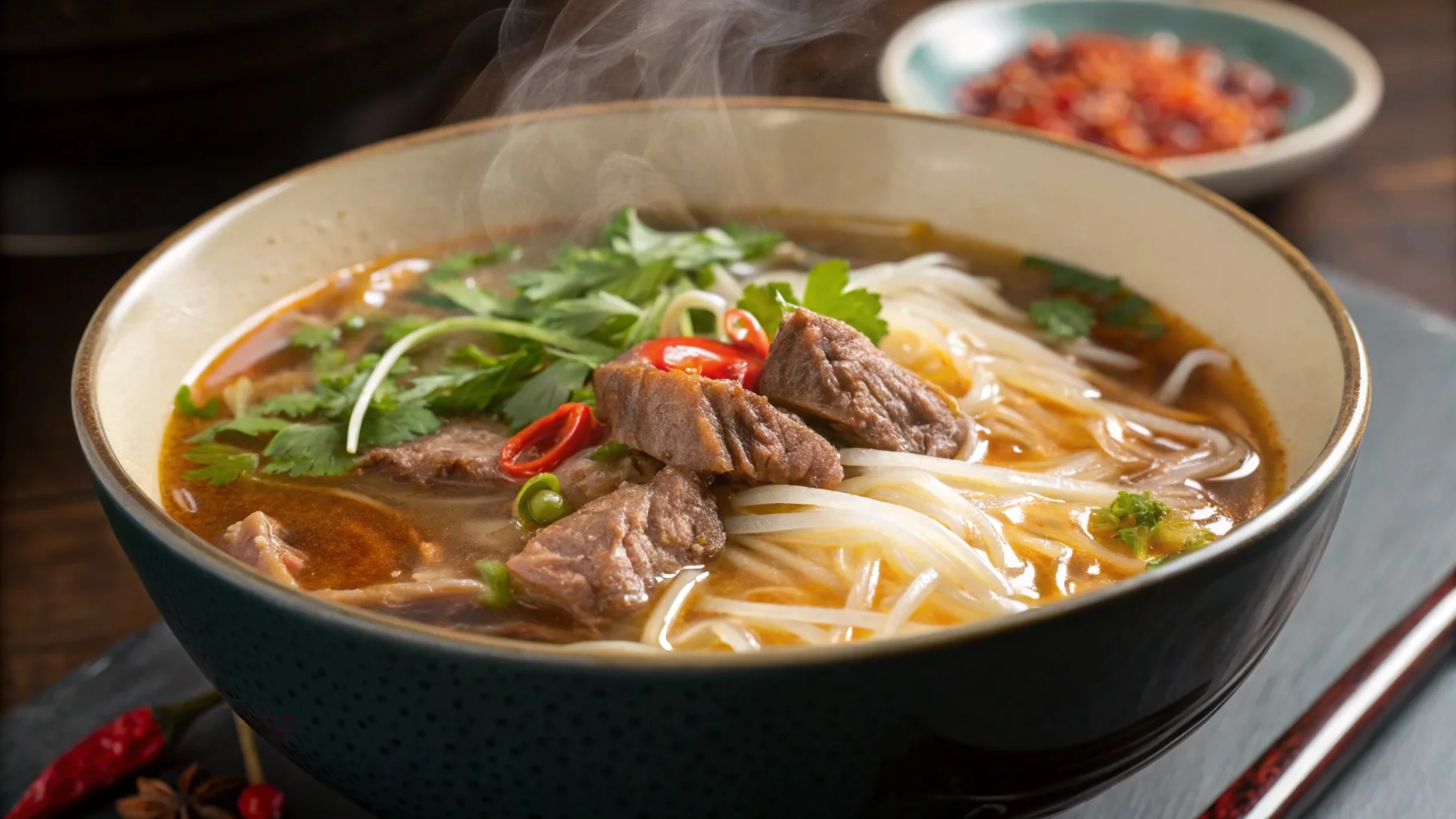Imagine enjoying a meal that comforts your soul and nourishes your body. Beef tendon is perfect for this. It’s often overlooked but is a culinary treasure. Its tender texture and ability to soak up flavors make it a key ingredient in many dishes.
Whether you’re looking to recreate childhood favorites or try new recipes, this ingredient offers a unique taste experience that brings warmth and satisfaction with every bite.
It’s also good for you low in calories and rich in collagen. This makes it a guilt-free choice for indulging. Each dish, like the Japanese Beef Tendon Stew, is a step toward healthier eating.
So, put on your apron and get ready to explore this comforting culinary world!
Table of contents
Introduction to Beef Tendon
Many people undoubtedly discover the unique value of this ingredient when trying new foods. Additionally, often overlooked, it explicitly adds great texture and taste to dishes. Moreover, learning more about it opens up new culinary possibilities, including recipes like pho and gyusuji nikomi.
Furthermore, if you enjoy cooking, adding this delicacy undoubtedly elevates your meals. Additionally, it plays a key role in many traditional dishes, thereby showcasing deep cultural significance. Moreover, chefs and home cooks alike value it for its flavor absorption, making every bite undeniably special.
Finally, by exploring its potential, you’ll explicitly discover many ways to prepare it. Additionally, techniques like slow braising or pressure cooking undeniably yield tender, rich results. Therefore, as you embark on this culinary adventure, this ingredient could undoubtedly become a favorite in your kitchen.
Beef Tendon Nutrition
Health Benefits
Beef tendon is full of health perks. It’s rich in collagen, which is good for your joints. It also has a lot of protein, helping your muscles and tissues.
| Nutrient | Per 100g Serving |
|---|---|
| Calories | 200 |
| Total Fat | 6g |
| Protein | 33g |
| Collagen | 25g |
Beef tendon has about 200 calories per 100g. This makes it a nutritious choice for many dishes. It’s good for your skin, hair, nails, and joints. Want to try more beef recipes? Check out this guide to beef recipes for inspiration.
Where to Buy
Finding high-quality beef tendon is key for a tasty and healthy meal. Local butcher shops and specialty Asian markets are great places to look. They often have fresh beef tendon, which is the best for cooking.
Check your neighborhood for Chinese, Vietnamese, or Thai grocery stores. Additionally, these shops explicitly offer fresh, frozen, and pre-cooked meat tendon. Moreover, each type is undeniably perfect for different cooking needs. Furthermore, if you can’t find what you need locally, many online retailers undoubtedly sell beef tendon and deliver it straight to your door.
Here are some tips for selecting quality:
- Look for a glossy appearance, indicating proper cooking methods.
- Choose pieces with a firm texture that will hold up well during cooking.
- Ensure the tendon has minimal surface impurities; soak in cold water or blanch in boiling water if necessary.
To help you more, here’s a comparison of available types:
| Type | Texture | Cooking Method | Flavor |
|---|---|---|---|
| Fresh | Chewy and gelatinous | Braising, stewing | Mild |
| Frozen | Potentially softer | Pressure cooking, roasting | Enhanced with spices |
| Pre-cooked | Ready to eat | Grilling, casseroles | Subtle flavor |

By knowing your options and where to buy beef tendon, you can improve your cooking. You can also try new flavors from different cuisines.
Pro Tip: When shopping for tendon, ensure it has a glossy appearance and firm texture. This ensures better results during cooking. For additional cooking tips, explore our Yakiniku Sauce recipe for added umami flavor to your dishes.
Preparing for Cooking
Preparing beef tendon needs careful attention for a tasty dish. Knowing how to clean it right makes it taste better and smell fresher. This step is key to a great meal.
Cleaning and Deodorizing Tips
Cleaning beef tendon well gets rid of dirt and bad smells. Here’s how to do it right:
- Rinse thoroughly: First, rinse the tendon under cold water to get rid of surface dirt.
- Soak in vinegar solution: Next, soak it in vinegar and water for 30 minutes. This cuts down on odors and boosts flavor.
- Boil briefly: Then, boil it in water for a few minutes to get rid of any lingering smells. Throw out the water after.
- Final rinse: Lastly, rinse it under cold water again. This removes any leftover vinegar and dirt.
By following these steps, you’re ready for a delicious cooking experience. Your tendon will be clean and ready to soak up the flavors of your recipe.

Delicious Beef Tendon Recipes
Beef Tendon Pho Recipe
This traditional Vietnamese dish is undeniably a comforting choice. Additionally, the spice-infused broth and tender beef tendons explicitly create an irresistible combination. Furthermore, here are the essential components:
- 1 pound beef tendon
- 8 cups water
- 1 large onion, charred
- 2 inches fresh ginger, bruised
- 4-star anise
- 3 cloves
- 1 cinnamon stick
- 1 tablespoon fish sauce
- Rice noodles
- Fresh herbs (basil, cilantro)
- Bean sprouts
- Sliced chili peppers
- Lime wedges
Start by simmering your beef tendon with water, onion, and ginger for several hours until tender. Add spices for flavor. Serve over rice noodles, topped with fresh herbs and accouterments. This Recipe will surely warm your heart.
Japanese Beef Tendon Stew (Gyusuji Nikomi)
This hearty stew undeniably showcases beef tendon in a delightful way. Additionally, here are the ingredients explicitly needed for this delicious recipe:
| Ingredient | Amount |
|---|---|
| Boiled beef tendon | 250g |
| Japanese white radish | 500g |
| Soy sauce | 80g |
| Sugar | 20g |
| Mirin | 20g |
| Sake | 20g |
| Vinegar | 8g |
| Green part of white leek | 1 piece |
| White onion | 10g |
| Japanese mustard | Moderate amount |
For cooking, cut the Japanese radish and place it in a pressure cooker with beef tendon and other ingredients. Cook under pressure for 15 minutes, then simmer to reduce the broth. Serve with white onions and a touch of mustard for a comforting meal.
Nutritionally, each serving of this recipe stew provides:
- 222 kcal
- 26g protein
- 4.3g fat
- 20.6g carbs
- 4.1g salt equivalent
With these delicious recipes, you can enjoy hearty and nutritious meals that showcase the versatility of beef tendon.
Cooking Methods
Choosing the right cooking method for beef tendon is undeniably key. Additionally, it explicitly affects the dish’s texture and taste. Moreover, slow cooking and pressure cooking are two popular methods. Furthermore, they offer different benefits, depending on your taste or time preference.
Slow Cooking vs. Pressure Cooking
Slow cooking undeniably makes beef tendon tender and flavorful. Additionally, it takes 4 to 8 hours, depending on the recipe. Moreover, the low heat explicitly lets flavors blend well, making it perfect for traditional dishes.
On the other hand, pressure cooking is quicker and ideal for busy schedules. Furthermore, it tenderizes the beef in just 30 to 45 minutes. Additionally, the high pressure seals in moisture and flavor. However, it might lack the slow-cooked depth of flavor.
| Method | Cooking Time | Flavor Development | Tenderness |
|---|---|---|---|
| Slow Cooking | 4 – 8 hours | Deep, rich flavor | Very tender |
| Pressure Cooking | 30 – 45 minutes | Concentrated flavor | Tender |
Both methods have their uses in cooking. Try both to find the perfect mix of taste and convenience for your beef tendon dishes.
Beef Tendon in Different Cuisines
Beef tendon is undeniably a standout ingredient in many global cuisines. Additionally, it’s explicitly celebrated in Chinese, Japanese, and Southeast Asian dishes. Moreover, each culture adds its own twist, making it famous for its taste and texture.
In Chinese cuisine, tendon is often found in noodles and soups. Furthermore, the slow-cooked tendon becomes tender, soaking up the flavors of spices and broth. Additionally, beef tendon soup is a favorite, loved by both home cooks and chefs alike.
In Japanese cuisine, meat tendon is also a key ingredient. It’s used in gyudon, or beef bowl, to make a hearty meal. Stews and hot pots also feature it, adding a luxurious feel to the dish.
Southeast Asian dishes, like Vietnamese and Thai cooking, also use tendon. Pho, a popular Vietnamese dish, includes it to boost the soup’s taste and body. Thai curries also use it, adding depth and richness.
Beef tendon’s versatility undeniably shows its global appeal. Additionally, discovering different ways it’s prepared explicitly highlights its many flavors. Furthermore, these dishes undoubtedly demonstrate how this simple ingredient creates amazing culinary experiences.
Is Beef Tendon Good to Eat?
Many wonder if is is good to eat. It adds a special texture to dishes, like pho. Its rich flavor makes it a hit with food lovers.
Beef tendon is known for its chewy texture, thanks to its collagen. It gives broth-based dishes a unique taste. For instance, is tendon in pho good? Yes, it makes the soup tender and rich.
But, there are health concerns. Eating too much red meat, including Cattle tendon, can be risky. Well-done beef might increase cancer risks. So, eating it in moderation is key.
Health experts suggest eating beef tendon in a balanced diet. This way, you enjoy its taste and texture without health worries. Adding it to meals now and then is a good idea.
FAQ
What is beef tendon?
Is beef tendon good to eat?
What are the nutritional benefits of beef tendon?
Where can I buy beef tendon?
How do I prepare beef tendon for cooking?
Are there specific recipes for beef tendon?
What are the cooking methods for beef tendon?
Is beef tendon hard to digest?
Does beef tendon melt during cooking?
How does beef tendon fit into different cuisines?
Conclusion
Beef tendon is often ignored in cooking, but it’s delicious and nutritious. It adds a unique texture and flavor to dishes. When you try beef tendon recipes, you’ll see it can be a main attraction in your cooking.
This ingredient is great in soups, stews, and more. Its versatility makes it a favorite among adventurous cooks. It shines in many cuisines.
This article showed the health benefits of beef tendon, like its collagen for joint health. It’s also packed with nutrients, making it perfect for healthy meals. You can try recipes like Beef Tendon Pho and Japanese Gyusuji Nikomi.
Adding beef tendon to your meals makes your cooking more interesting. It brings a rich flavor that’s hard to ignore.
Ready to explore more recipes, tips, and inspiration? Follow us on Facebook for updates and join our community of passionate food lovers!

